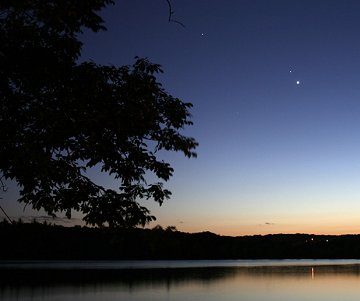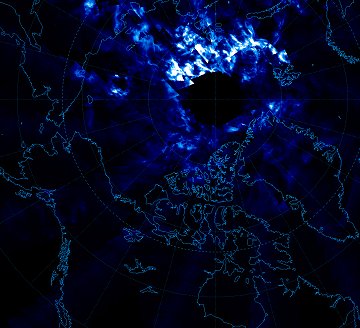 Where's Saturn? Is that a UFO--or the ISS? What's the name of that star? Get the answers from mySKY--a fun new astronomy helper from Meade. Where's Saturn? Is that a UFO--or the ISS? What's the name of that star? Get the answers from mySKY--a fun new astronomy helper from Meade. SUMMER MOON ILLUSION: For sky watchers in the northern hemisphere, this weekend is the best time of year to experience the mysterious and beautiful Moon Illusion: full story. VENUS AND SATURN: Step outside this evening at sunset, just as the sky is fading to black, and look west. Venus and Saturn are having a beautiful close encounter. Imelda Joson and Edwin Aguirre send this picture from Horn Pond, Massachusetts: 
"We took the picture on Friday evening (June 29th) in preparation for the planets' close approach on Saturday," say Joson and Aguirre. "As Venus and Saturn were setting over Horn Pond, they produced a nice pair of glitter paths on the water's surface." Tonight the planets are at their closest--only 2/3o apart, which means you can hide them both behind the tip of your index finger held at arm's length. If you have a backyard telescope, set it up. Even small 'scopes reveal the rings of Saturn and the surprising crescent shape of Venus: sky map. more images: from Wade Howlett of Bullsbrook, Western Australia; from Domenico Licchelli of Porta Rudiae, Lecce, Italy; from Enrico Perissinotto of Premariacco (UD) Italy; from Serdar Hepgul of Istanbul Turkey; from Mike Bromley of Maradah, Libya (the tower pictured in this photo is an oil rig); from Peter Rosén of Stockholm, Sweden; NLCs FROM ABOVE: For the first time ever, humans know what a noctilucent cloud (NLC) looks like--from above. NASA's AIM spacecraft took this composite UV-wavelength picture on June 11th from a vantage point 600 km over Earth's north pole: 
Launched on April 25, 2007, AIM is on a mission to study these mysterious clouds at the edge of space; the image above represents its first good look. For the next two years, AIM will monitor the life cycle of NLCs, assaying their chemistry and particulate content, and checking to see if space dust plays a role in their genesis. When NLCs were first sighted in the 19th century, they were confined to polar latitudes, but lately they have intensified and spread with sightings in recent years as far south as Colorado and Utah. "It is clear that these clouds are changing, a sign that a part of our atmosphere is changing and we do not understand how or what it means," says AIM principal investigator James Russell III of Hampton University. Are NLCs a sign of global warming? Or something else? Researchers hope AIM will provide some answers. Stay tuned for updates. June 2007 Noctilucent Cloud Gallery
["Noctilucent Cloud"--the song] [Night-Sky Cameras] | 
